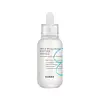What's inside
What's inside
 Key Ingredients
Key Ingredients

 Benefits
Benefits

 Concerns
Concerns

No concerns
 Ingredients Side-by-side
Ingredients Side-by-side

Water
Skin ConditioningGlycerin
HumectantButylene Glycol
HumectantDipropylene Glycol
Humectant1,2-Hexanediol
Skin ConditioningMethyl Gluceth-10
EmulsifyingSodium Hyaluronate
HumectantCarbomer
Emulsion StabilisingPanthenol
Skin ConditioningTromethamine
BufferingEthylhexylglycerin
Skin ConditioningHyaluronic Acid
HumectantHydrolyzed Hyaluronic Acid
HumectantGluconolactone
Skin ConditioningLactobionic Acid
BufferingWater
Skin ConditioningKaolin
AbrasiveGlycerin
HumectantBentonite
AbsorbentArtemisia Princeps Extract
Skin ConditioningStearic Acid
CleansingPanthenol
Skin Conditioning1,2-Hexanediol
Skin ConditioningIllite
AbrasiveArtemisia Montana Leaf Powder
ExfoliatingCamellia Sinensis Leaf Water
MaskingCastanea Crenata Shell Extract
Skin ConditioningOriganum Vulgare Leaf Extract
Skin ConditioningChamaecyparis Obtusa Leaf Extract
Skin ConditioningSalix Alba Bark Extract
AstringentAvena Sativa Kernel Extract
AbrasiveCynara Scolymus Leaf Extract
Skin ConditioningPortulaca Oleracea Extract
Skin ConditioningCinnamomum Cassia Bark Extract
MaskingScutellaria Baicalensis Root Extract
AstringentMontmorillonite
AbsorbentCalcite
Skin ConditioningPhaseolus Angularis Seed Powder
Canadian Colloidal Clay
Skin ConditioningHydrogenated Lecithin
EmulsifyingBeta-Glucan
Skin ConditioningMethylpropanediol
SolventAlgin
MaskingMagnesium Aluminum Silicate
AbsorbentCetyl Alcohol
EmollientButylene Glycol
HumectantXanthan Gum
EmulsifyingAllantoin
Skin ConditioningTromethamine
BufferingPolyquaternium-51
Skin ConditioningEthylhexylglycerin
Skin ConditioningWater, Kaolin, Glycerin, Bentonite, Artemisia Princeps Extract, Stearic Acid, Panthenol, 1,2-Hexanediol, Illite, Artemisia Montana Leaf Powder, Camellia Sinensis Leaf Water, Castanea Crenata Shell Extract, Origanum Vulgare Leaf Extract, Chamaecyparis Obtusa Leaf Extract, Salix Alba Bark Extract, Avena Sativa Kernel Extract, Cynara Scolymus Leaf Extract, Portulaca Oleracea Extract, Cinnamomum Cassia Bark Extract, Scutellaria Baicalensis Root Extract, Montmorillonite, Calcite, Phaseolus Angularis Seed Powder, Canadian Colloidal Clay, Hydrogenated Lecithin, Beta-Glucan, Methylpropanediol, Algin, Magnesium Aluminum Silicate, Cetyl Alcohol, Butylene Glycol, Xanthan Gum, Allantoin, Tromethamine, Polyquaternium-51, Ethylhexylglycerin
 Reviews
Reviews

Ingredients Explained
These ingredients are found in both products.
Ingredients higher up in an ingredient list are typically present in a larger amount.
1,2-Hexanediol is a synthetic liquid and another multi-functional powerhouse.
It is a:
- Humectant, drawing moisture into the skin
- Emollient, helping to soften skin
- Solvent, dispersing and stabilizing formulas
- Preservative booster, enhancing the antimicrobial activity of other preservatives
Butylene Glycol (or BG) is used within cosmetic products for a few different reasons:
Overall, Butylene Glycol is a safe and well-rounded ingredient that works well with other ingredients.
Though this ingredient works well with most skin types, some people with sensitive skin may experience a reaction such as allergic rashes, closed comedones, or itchiness.
Learn more about Butylene GlycolEthylhexylglycerin (we can't pronounce this either) is commonly used as a preservative and skin softener. It is derived from glyceryl.
You might see Ethylhexylglycerin often paired with other preservatives such as phenoxyethanol. Ethylhexylglycerin has been found to increase the effectiveness of these other preservatives.
Glycerin is already naturally found in your skin. It helps moisturize and protect your skin.
A study from 2016 found glycerin to be more effective as a humectant than AHAs and hyaluronic acid.
As a humectant, it helps the skin stay hydrated by pulling moisture to your skin. The low molecular weight of glycerin allows it to pull moisture into the deeper layers of your skin.
Hydrated skin improves your skin barrier; Your skin barrier helps protect against irritants and bacteria.
Glycerin has also been found to have antimicrobial and antiviral properties. Due to these properties, glycerin is often used in wound and burn treatments.
In cosmetics, glycerin is usually derived from plants such as soybean or palm. However, it can also be sourced from animals, such as tallow or animal fat.
This ingredient is organic, colorless, odorless, and non-toxic.
Glycerin is the name for this ingredient in American English. British English uses Glycerol/Glycerine.
Learn more about GlycerinPanthenol is a common ingredient that helps hydrate and soothe the skin. It is found naturally in our skin and hair.
There are two forms of panthenol: D and L.
D-panthenol is also known as dexpanthenol. Most cosmetics use dexpanthenol or a mixture of D and L-panthenol.
Panthenol is famous due to its ability to go deeper into the skin's layers. Using this ingredient has numerous pros (and no cons):
Like hyaluronic acid, panthenol is a humectant. Humectants are able to bind and hold large amounts of water to keep skin hydrated.
This ingredient works well for wound healing. It works by increasing tissue in the wound and helps close open wounds.
Once oxidized, panthenol converts to pantothenic acid. Panthothenic acid is found in all living cells.
This ingredient is also referred to as pro-vitamin B5.
Learn more about PanthenolTromethamine helps balance the pH and improve the texture of a product. It is synthetically created.
As an emulsifier, Tromethamine prevents oil and water ingredients from separating. This helps stabilize the product and elongate a product's shelf life. Tromethamine also makes a product thicker.
Tromethamine helps balance the pH level of a product. Normal pH level of skin is slightly acidic (~4.75-5.5). The acidity of our skin is maintained by our glands and skin biome. Being slightly acidic allows our skin to create an "acid mantle". This acid mantle is a thin barrier that protects our skin from bacteria and contaminants.
Oral Tromethanmine is an anti-inflammatory drug but plays the role of masking, adding fragrance, and/or balancing pH in skincare.
1,3-Propanediol, 2-amino-2-(hydroxymethyl)-
Learn more about TromethamineWater. It's the most common cosmetic ingredient of all. You'll usually see it at the top of ingredient lists, meaning that it makes up the largest part of the product.
So why is it so popular? Water most often acts as a solvent - this means that it helps dissolve other ingredients into the formulation.
You'll also recognize water as that liquid we all need to stay alive. If you see this, drink a glass of water. Stay hydrated!
Learn more about Water